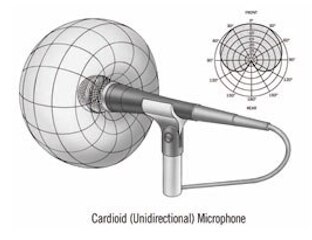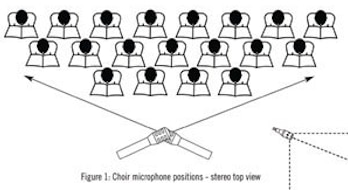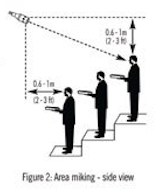The parts of a recording system
To make a decent recording there are two or three components to consider:
1. The first, and most important, is the microphone. Choosing the right microphone ensures accurate pickup of the desired sounds.
2. Next, consider the recording device. Recording equipment comes in many shapes and sizes. In the past, many people used simple cassette tape recorders. These days, most recorders are digital in nature.
3. Lastly, depending on the capabilities of the recording device, you may need a mixer. A mixer's purpose is twofold; they are used to combine (or "mix") multiple microphones together, and to properly interface microphones to the recording device. A microphone has an extremely low output level that would result in little or no signal actually making it to the recorder. A mixer provides gain, which raises the signal level from the microphone to a level that is acceptable to recorders that don't have microphone inputs.
Microphones
The most important questions to ask when choosing microphones are: a) what are you recording? and b) what are you using to record? 
First, a little about microphones. Microphones are simple devices designed to do one thing: convert sound waves in the air to their electrical equivalent. One of the first questions you may encounter is, "Do you want a dynamic or condenser microphone?" These are the two most popular types of microphones.
- Dynamic microphones are typically inexpensive and rugged, with fairly low sensitivity. In layman's terms, this means they are good for handheld or "close-miked" applications. Dynamics are commonly used for solo vocalists and on drum kits.
- Condenser microphones, on the other hand, are typically (but not always) much more sensitive than dynamics. Make a good quality condenser microphone your first choice for miking ensembles, or other applications where the microphone will be placed at a distance (more than 2 feet) from the sound source. Condensers are typically used for recording orchestras, choirs, and in other applications where you wish to capture the sound of the ensemble, versus individual sounds.
 Another characteristic of microphones that will determine the best choice for your application is their directionality, or "polar pattern."
Another characteristic of microphones that will determine the best choice for your application is their directionality, or "polar pattern."
An omnidirectional microphone has equal sensitivity at any angle. Sounds are reproduced equally whether arriving at 0 degrees (on axis) or at 180 degrees (the rear of the mic). The important thing to remember is that omnidirectional microphones will pick up ambient or room sound as well as the sound you intend to amplify or record.
A unidirectional microphone is most sensitive to sound arriving on axis and less sensitive to sound as it moves off axis. Using unidirectional microphones can allow higher gain levels from the sound system before feedback becomes a problem. There are two primary types of unidirectional microphones. Cardioid microphones exhibit an upside down heart-shaped pattern with a 130-degree pickup angle in front. Sound is greatly attenuated at 180 degrees. Supercardioid microphones exhibit a narrower pickup angle of around 115 degrees in front and therefore are even less sensitive to ambient sounds.
Capturing the Sound of Large Ensembles (Band, Orchestra, Choir)
 Use a stereo microphone setup to most accurately capture the sound of a large ensemble. Stereo recording is not as complicated as it sounds. For simplicity sake, we'll use the most basic type of stereo microphone techniques, the X-Y pattern. Use two microphones of the same model with the two mic capsules placed as close as possible, and facing each other at an angle ranging from 90-135 degrees, depending on the size of the sound source (see figure 1). For a wider coverage area, the larger angles should be used. The X-Y pattern results in good stereo separation and excellent mono compatibility.
Use a stereo microphone setup to most accurately capture the sound of a large ensemble. Stereo recording is not as complicated as it sounds. For simplicity sake, we'll use the most basic type of stereo microphone techniques, the X-Y pattern. Use two microphones of the same model with the two mic capsules placed as close as possible, and facing each other at an angle ranging from 90-135 degrees, depending on the size of the sound source (see figure 1). For a wider coverage area, the larger angles should be used. The X-Y pattern results in good stereo separation and excellent mono compatibility.
A second, somewhat simpler way to record in stereo uses what is known as a "single-point" stereo microphone. These types typically have a single microphone housing that contains two microphone elements, electrically combined to produce a stereo output. The advantage to this type of microphone is simplicity: put the microphone on a stand and point it at what you want to record.
When recording a large ensemble, you may choose to use more than two microphones to adequately cover each section. A technique known as "area" coverage uses multiple microphones to cover small sections of the ensemble. Using a choir as an example, use one microphone for each 6-9 foot wide section, and aim the microphone capsule towards the last row. Microphones should be placed 2-3 feet in front of the first row of the choir (see figure 2). The same technique can be applied to concert band or orchestra, by using one microphone per section. 
Recording Content Provided by: Shure
by Gino Sigismondi

